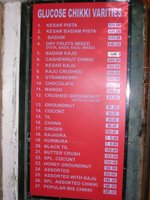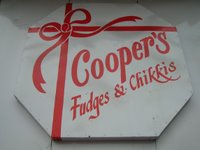
You have gone to Lonavala for the first time ever and someone has told you that it's famous for chikki. So you wander around the roads parallel to both sides of the railway station and see the following Chikki stores…National, Maganlal, Rupam, Navratna, another Maganlal, Mahavir, Raval, another Maganlal, Super, Vaishali, another Maganlal, another Maganlal, Mangal, Panchratna, Coopers, Friends, Purohit, Santosh, Golden and another Maganlal and then you are left confused as to which place you should buy it from. You then try and compare two shops and you are bound to be confused further as you will get the same 30 varieties of chikki for more of less the same price per kilo. So what is the Lonavala chikki all about? Here is everything you wanted to know about the Lonavala chikki and didn't know whom to ask.
Origin of chikki in Lonavala
Lonavala was so named because of the word 'lenya' which means caves in Marathi. There are many rock-cut caves, which surround Lonavala. It was Shri Maganlal Agarwal (the fourth generation of Maganlal Agarwal's family is now running the chikki business) who brought chikki to Lonavala more than 125 years ago. His great grandson, Ashutosh Agarwal told me that it all started when Shri Maganlal began selling 'gurdana', a mixture of jaggery and groundnuts in a huge sack to the laborers who were laying tracks on the Khandala–Pune railway line. (Opened to traffic in 1858) He used to stand with the big sack, next to the railway line, literally outside where the Maganlal's main shop stands now in the market street on the east side and sold the 'gurdana'. 'Gurdana' is rich in protein and iron and the laborers used to consume it for the instant energy. Later, the simple 'gurdana' graduated to the groundnut chikki and over the years other chikki varieties were introduced. Nevertheless, the whole and crushed groundnut chikki are still Maganlal's bread and butter product making up for 70% of the total chikki varieties sold.
Choosing the right Chikki
Recipe
Chikki is made from four basic ingredients… jaggery, sugar, liquid glucose (it acts as a binding agent) and the basic material (groundnut, cashew, til etc). If crushed groundnut chikki has to be made then a measured portion of the groundnut is roasted and then crushed after its skin has been removed. In a kadhai, over a flame, syrup of jaggery and liquid glucose is prepared. The crushed groundnut is added to this mixture and some sugar powder is added. This prepared mixture is pressed and rolled out on wooden planks to make a uniform thick layer, which is then cut square pieces with a cutter. This becomes chikki, which is ready to be packed and sold.
Variety

Chikki are available in more than 30 varieties. So choose the one whose basic ingredient you like. They have cashew, groundnut (crushed and whole), chana, kesar pista, badam, coconut, rajgira, kurmura, til, dry fruits mixed and permutations and combination of all these. - Some chikki which I thought were unique (may not be tasty) were ginger, honey peanut and mint crush.
- The price per kilo starts at Rs 80 for groundnut, til, chana chikki to Rs 520 for kesar pista.
- Some chikki like strawberry, mango, chocolate would be made without jaggery and would have mava and fruit pulp in them.
- The calorie conscious need not worry, there are "low calorie and sugar free" chikki like Groundnut (whole and crush) available.
- Jaggery is not added to some chikki like cashew as it becomes very dark and does 'not look good' in Ashutosh Agarwal's words.
Quality
With so little differentiation between different brands, it is very difficult to make out what makes a good quality chikki.
A good and fresh chikki will be crisp and not soft. The chikki sold on the trains may generally not be fresh so do look up the manufacturing date.
The color of the chikki should medium brown (groundnut), i.e. not too dark or light. If it too light then the manufacturer has used less jaggery to save on costs and if it too dark then it has been in the kadhai for a longer time than required.
The manufacturer might try and save on the costs of expensive ingredients like cashews, badam, pista etc by putting less of it in the chikki. You can make it out by just looking at the chikki as the distance between two cashew pieces will be more and there will be more sugar/liquid glucose added.
Some manufacturers may use materials of low grade quality (cashews, groundnuts, almonds etc).
Brand
As I have mentioned before, there are around 30-40 brands of chikki sold in Lonavala. So which one is the best? I generally buy chikki from three stores. Maganlal, National and A-1. Why these three. Firstly because the quality of chikki sold is better than the others. Secondly, one of them is the inventor of the Lonavala chikki and so is bound to be good (Maganlal) and thirdly, because these three brands were the ones that my grandfather, uncle and father used to buy for many many years, so check on word of mouth for recommendations.
And how do I decide which of these three I would buy the chikki from. This would depend on the time I have to buy chikki. When there was no expressway and the Bombay-Pune Asiad buses used to halt for a break at Lonavala, I used to quickly run across to A-1, as it was the closest of the three to the Asiad bus stand and buy the chikki. If I was going to change a train at Lonavala, then I used to buy it from Maganlal/National, as they are closer than A-1 to the railway line. If I was staying in Lonavala and had lots of time, I would buy it from National, Maganlal or A-1 in that order.
Maganlal also has many franchises and that is why you will see lots of Maganlal shops all over Lonavala. Thus, if you want to buy it from the original Maganlal, it is located on the east side (the other side of the Mumbai- Pune highway) and is between the National Chikki Mart and Coopers fudge shop.
Not just chikki

For all those who don't like chikki, Lonavala has more to offer…you can buy other stuff like fudges (try the Coopers chocolate walnut fudge at a princely sum of 600 Rs a kilo and go there early as it gets over pretty quickly), farsans, chivdas (try the corn flake chivda at National Chikki Mart), barfis and other stuff like pickles, honey, wafers, syrups and squashes which you will anyway get in Bombay.
And by the way, I am writing this chomping on three kinds of chikki… whole groundnut, crushed groundnut and cashew, all bought from the original Maganlal.
 Rani, the stray featured in the photograph alongside was run over in the most terrible manner outside the VSNL building at Fountain by a taxi and then a BEST bus last Monday. Vijayan, her owner called us in a panic and our volunteer Prerna reached there in 10 minutes to take her to the WSD kennels. She had bled excessively and thus could not make it.
Rani, the stray featured in the photograph alongside was run over in the most terrible manner outside the VSNL building at Fountain by a taxi and then a BEST bus last Monday. Vijayan, her owner called us in a panic and our volunteer Prerna reached there in 10 minutes to take her to the WSD kennels. She had bled excessively and thus could not make it.





